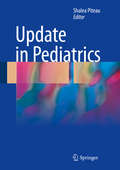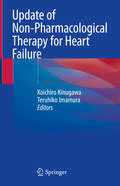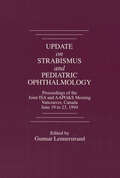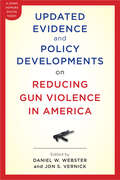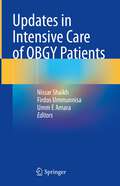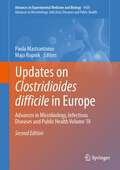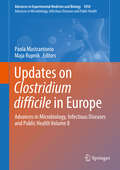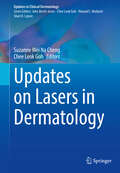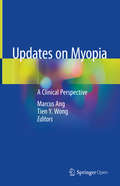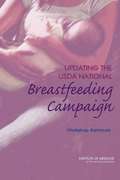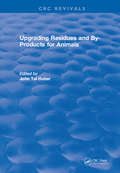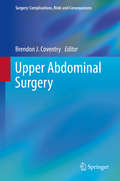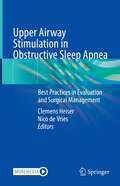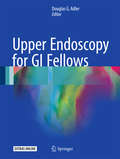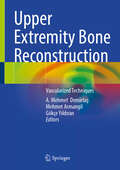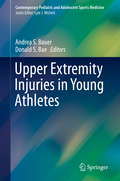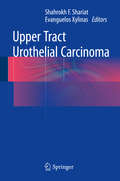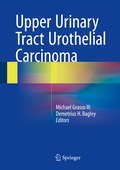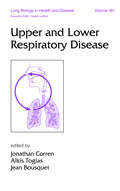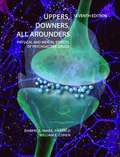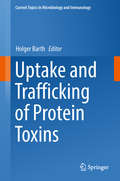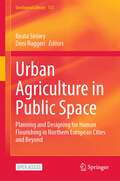- Table View
- List View
Update in Pediatrics
by Shalea PiteauThis concise and comprehensive volume updates health professionals on recent advances in the field of pediatrics. It includes chapters in every subspecialty of pediatrics, such as critical care, development emergency medicine and genetics. Ranging from traditional disciplines such as infectious disease and cardiology to more current disciplines such as adolescent medicine, metabolics and genetics this is an indispensable guide for the busy clinician who wishes to stay up-to date with latest advances in the field.Through the use of summaries and bullet points, the book conciselly describes the latest recommendations and guidelines in pediatrics and provides a good overview of the available technology for each subspecialty.The team of authors is made up of experienced clinicians and researchers in their respective fields. This book appeals to pediatricians, family doctors, nurses and nurse practitioners, allied health professionals, and health researchers.
Update of Non-Pharmacological Therapy for Heart Failure
by Koichiro Kinugawa Teruhiko ImamuraThis book offers essential guidance on the diagnosis, management and treatment of heart failure using the latest Ventricular Assist Devices and approaches such as Cardiac Resynchronization Therapy, Implantable Cardioverter Defibrillator, Non-invasive Positive Pressure Ventilation, Intra-Aortic Balloon Pumping, Extra Corporeal Membrane Oxygenation and so on. It provides practical guidelines on the monitoring using those devices, as well as techniques and treatment strategies, and features two dedicated chapters on heart transplants and regenerative therapy. The main content is complemented by a wealth of full-color figures and diagrams to clearly demonstrate the operative techniques and tools discussed. Given its scope, Update on Non-pharmacological Therapy for Heart Failure offers a valuable resource, not only for cardiologists and cardiac surgeons, but also for clinical residents and medical students.
Update on Strabismus and Pediatric Ophthalmology Proceedings of the June, 1994 Joint ISA and AAPO&S Meeting, Vancouver, Canada
by Gunnar Lennerstrand Shinobu AwayaThis book provides useful information on new observations and therapeutic approaches to common problems encountered in strabismus and pediatric ophthalmology. It also discusses the ocular findings in a number of rare conditions.All aspects of pediatric ophthalmology are addressed. The book describes a new strabismic condition and provides updates on research in the development of normal and abnormal monocular and binocular vision, and in ocular motility. All different strabismus types and their characterizations are covered, as well as nystagmus and other ocular motor disorders. The latest advances in relevant surgical and pharmacological management are discussed. Recent research on diseases of the lacrimal system, the anterior segment, cataracts, posterior segment, and neuro-ophthalmology is extensively covered.Update on Strabismus and Pediatric Ophthalmology presents the proceedings of the joint meeting of the VIIth Congress of the International Strabismological Association (ISA) and the 20th Annual Meeting of the American Association for Pediatric Ophthalmology and Strabismus (AAPO&S). The meeting had more than 750 participants, making it the largest conference ever held in the field of strabismus and pediatric ophthalmology.
Updated Evidence and Policy Developments on Reducing Gun Violence in America
by Daniel W. Webster Jon S. VernickThis digital update to Reducing Gun Violence in America presents new evidence and developments in the effort to address the staggering toll of gun violence in the United States.In 2013—in the wake of the tragic shooting at Sandy Hook Elementary School—Johns Hopkins University Press published Reducing Gun Violence in America, a collection of essays written by the world’s leading experts on gun violence. Updated Evidence and Policy Developments on Reducing Gun Violence in America follows up on the state of American gun violence by analyzing new data, research, and policy developments one year after Sandy Hook. Over the course of ten substantive chapter addendums, contributors bring readers up-to-date on such varied topics as mental illness, domestic violence, background checks, illegal gun sales, and personalized guns. They describe the recent policy measures that have been enacted and suggest additional approaches that may help stem the violence. An essential companion to Reducing Gun Violence in America, the reliable, empirical research and legal analysis in this e-book will help lawmakers, opinion leaders, and concerned citizens identify policy changes to address gun violence, which takes an average of more than 80 lives every day in the United States.
Updates in Intensive Care of OBGY Patients
by Nissar Shaikh Firdos Ummunnisa Umm E AmaraThis book presents the updated management of acute and critically ill obstetric and gynecological patients. It describes patients' care with pregnancy-induced medical disorders, comorbidities, and gynecological (OBGY) conditions requiring acute and intensive care support therapy. This book will guide early diagnosis and speedy management of life-threatening conditions. Chapters provide a comprehensive and systemic approach in an easy-to-understand format. Along with diseases and comorbidities of pregnancy, acute illness and its management caused by in vitro fertilization (IVF) are focused on, and a dedicated chapter about COVID-19 infection in obstetric patients is provided.Updates in Intensive Care of OBGY Patients will support intensivists, obstetricians, gynecologists, acute care physicians, and surgeons. Residents, fellows, specialists, and other junior medical staff working in intensive care units will also value this source. It will also help to broaden the understanding of nurses and paramedical staff in intensive care therapy.
Updates on Clostridioides difficile in Europe: Advances in Microbiology, Infectious Diseases and Public Health Volume 18 (Advances in Experimental Medicine and Biology #1435)
by Paola Mastrantonio Maja RupnikThis fully updated second edition outlines the currently available clinical, epidemiological and experimental data on Clostridioides difficile infections(CDI) with special emphasis on studies and results achieved in Europe. The incidence and severity of CDI has increased significantly over the last decade, and the book explains why C. difficile, recently reclassified as Clostridioides difficile, remains a significant challenge, also from economic perspective, to health care systems all over the world. The different reservoirs of this ubiquitous microorganism are reviewed as well as the different factors contributing to its virulence, such as toxins and biofilm formation. The rapid evolution of antibiotic resistance is clearly a concern and in a specific way can influence the CDI epidemiology. Additionally, new emerging strains and comparative genomics studies are taken into consideration for their relevance from epidemiological and evolutionary point of view. The book also gives an overview on diagnostics, therapy and surveillance, all of which are still challenging. Therefore, a closer look is taken on the effect of probiotics as an alternative to antibiotics, for prevention and treatment of CDI. Fecal transplantation from healthy donors, passive immunotherapies and vaccines for patients with recurrences are also discussed in dedicated chapters. New topics included sporulation and membrane vesicles in C. difficile. The book closes with a summary of the history and the achievements of the European Society of Clinical Microbiology and Infectious Diseases Study Group for Clostridium difficile (ESGCD) written by the current and past presidents of the Society. It is the aim of this book to raise awareness on CDI and to disseminate updated information on its prevention, diagnosis and treatment.
Updates on Clostridium difficile in Europe: Advances In Microbiology, Infectious Diseases And Public Health Volume 8 (Advances In Experimental Medicine And Biology #1050)
by Paola Mastrantonio Maja RupnikThis book outlines the currently available clinical, epidemiological and experimental data on Clostridium difficile infection (CDI) with special emphasis on studies and results achieved in Europe. The incidence and severity of CDI has increased significantly over the last decade, and the book explains why C. difficile, recently reclassified as Clostridioides difficile, remains a significant challenge, also from economic perspective, to health care systems all over the world. The different reservoirs of this ubiquitous microorganism are reviewed as well as the different factors contributing to its virulence, such as toxins and biofilm formation. The rapid evolution of antibiotic resistance is clearly a concern and in a specific way can influence the CDI epidemiology. Additionally, new emerging strains and comparative genomics studies are discussed for their relevance from epidemiological and evolutionary point of view. The book also gives an overview on diagnostics, therapy and surveillance, all of which are still challenging. Therefore, a closer look is taken on the effect of probiotics as an alternative to antibiotics, for prevention and treatment of CDI. Fecal transplantation from healthy donors, passive immunotherapies and vaccines for patients with recurrences are also discussed in dedicated chapters. The book closes with a summary of the history and the achievements of the European Society of Clinical Microbiology and Infectious Diseases Study Group for Clostridium difficile (ESGCD) written by the current and past presidents of the Society. It is the aim of this book to raise awareness on CDI and to disseminate updated information on its prevention, diagnosis and treatment.
Updates on Lasers in Dermatology (Updates in Clinical Dermatology)
by Chee Leok Goh Suzanne Wei Na ChengThis book is the first authoritative and comprehensive volume dedicated to updates and current best practices in lasers in Dermatology. It provides an up-to-date and highly illustrated synopsis of the therapeutic applications, efficacy and safety of lasers to treat both medical and cosmetic dermatological conditions. Chapters will focus on newer advances and techniques in laser treatment for medical dermatological conditions such as keloids, viral warts and infantile haemangioma, and a wide range of cosmetic indications such as skin tightening, skin rejuvenation, skin resurfacing, pigmentation, and the removal of birthmarks, acquired melanocytic naevi, tattoos and unwanted hair. Updates on Lasers in Dermatology is a must-have resource for dermatologists, aesthetic GPs, and other medical physicians/specialists.
Updates on Myopia: A Clinical Perspective
by Marcus Ang Tien Y. WongThis book is open access under a CC BY 4.0 license.This open access book discusses basic clinical concepts of myopia, prevention of progression and surgical treatments for myopia and pathological myopia. It also summarises the latest evidence and best practices for managing myopia, high myopia and its complications. Written by leading experts, the book addresses clinical diagnosis and interpretation of imaging modalities, and various complications of myopia such as glaucoma, choroidal neovascularization, retinal degeneration and cataracts. It is a valuable comprehensive resource for general and sub-specialist ophthalmologists as well as residents and ophthalmologists in training.
Updating the USDA National Breastfeeding Campaign: Workshop Summary
by Paula Tarnapol WhitacreSupport for breastfeeding has been a priority of the WIC program since its inception in the 1970s. The Loving Support Makes Breastfeeding Work campaign, which the U. S. Department of Agriculture's (USDA) Food and Nutrition Services launched in 1997, emphasizes key components needed for a breastfeeding mother to be successful. More than a decade after the campaign began, USDA wants to update it, taking into account changes in the WIC program, participants, and technology. On April 26, 2011, the IOM hosted a workshop to bring together experts to discuss what has changed since Loving Support began, lessons learned from other public health campaigns, and suggestions for where to take the campaign in the future.
Upgrading Residues and By-products for Animals
by J. Tal HuberAccumulation into one source of what is known regarding the feeding value of these materials and systems which have been developed for improving their digestibility, palatability or methods of handling was the motivation for organising this book. These has been an effort to include the major categories of unconventional materials which can potentially be upgraded to provide the ruminant with needed nutrients, but certainly some have been missed. It is hoped that this treatise will prove to be a valuable tool for workers involved in improving the utilization of residues and waste products for animals.
Upper Abdominal Surgery
by Brendon J. CoventryWritten by internationally acclaimed specialists, Upper Abdominal Surgery provides pertinent and concise procedure descriptions spanning benign and malignant problems and minimally invasive procedures. Complications are reviewed when appropriate for the organ system and problem, creating a book that is both comprehensive and accessible. Stages of operative approaches with relevant technical considerations are outlined in an easily understandable manner. The text is illustrated with photographs that depict anatomic or technical principles. Forming part of the series, Surgery: Complications, Risks and Consequences, this volume Upper Abdominal Surgery provides a valuable resource for all general surgeons and residents in training. Other healthcare providers will also find this a useful resource.
Upper Airway Disorders and Noninvasive Mechanical Ventilation: Rationale and Approaches
by Antonio M. Esquinas Andrea De Vito Nikolaos BarbetakisThis book analyses the basic rationale of noninvasive respiratory management in upper airways medical and perioperative disorders and key interactions and clinical implications. It offers key diagnostic tools to detect early and late failure of upper airway disorders whit a noninvasive approach. Furthermore, all medical and post-operative clinical indications of acute and chronic diseases in upper airway respiratory disorders and outcomes are summarized.The book can be considered unique from various perspectives: from the physiological and practical point of view as well as from the side of the therapeutic approach. As a matter of fact, from the physiological perspective, noninvasive mechanical ventilation has been shown to have several beneficial effects on the elasticity, musculature, and resistance of the upper and lower airways. Then, in the book the relationships between noninvasive respiratory management options and upper airway disorders in medical and postoperative conditions are also considered. Finally, the book provides information and analysis of the interaction of upper airways in the interaction of noninvasive mechanical ventilation management, which are the determining factors in the response in various clinical settings. Considering the growing evidence of the role of upper airways disorders in influencing the outcomes of noninvasive mechanical ventilation, in this book is presented a unique multidisciplinary approach to better understand the role of upper airways in noninvasive mechanical ventilation. The volume – richly illustrated – offers an exhaustive analysis of the role of the upper airways in patients who require treatment with noninvasive mechanical ventilation and can be considered a scientific reference for several specialists such as intensivists and anesthesiologists, pneumologists-sleep medicine professionals as well as otorhinolaryngologists.
Upper Airway Stimulation in Obstructive Sleep Apnea: Best Practices in Evaluation and Surgical Management
by Nico De Vries Clemens HeiserThis book by leading international experts provides an evidence-based approach to electrical stimulation of the upper airway, beginning with patient selection, implant techniques, trouble shootings, patient pathways, titrations during daytime and sleep as also new innovative techniques such as stimulation of the ansa cervicalis and the phrenic nerve. Key Features: · Superbly illustrated schematic drawings and full-colored photographs;· Step-by-step description of surgical concepts and techniques on all of the market available systems (Inspire, Nyxoah, LivaNova, Remede);· Complete online media library with videos on the surgical procedures;· New surgical steps presented for well established procedures (e.g. 2-incicions technique);· Discussion of outcomes, success rates, risks, and potential troubleshooting’s, where evidenced-based data are not available, expert opinion is provided. Upper Airway Stimulation in Obstructive Sleep Apnea will be welcomed by residents, fellows, and board-certified surgeons in otorhinolaryngology and head and neck surgery.
Upper Endoscopy for GI Fellows
by Douglas G. AdlerThis volume provides a concise overview of the most important and vital aspects of upper endoscopy. The text is specifically geared towards first-year GI fellows and novice endoscopists in order to help them rapidly assimilate the core concepts needed to perform upper endoscopy in the most important and most commonly encountered clinical situations. The book also covers the most important variations of normal anatomy and pathology and how to manage them. Key concepts covered include foreign body removal, diagnosis and management of upper GI bleeding, Barrett's Esophagus, evaluation and management of benign and malignant strictures of the esophagus, stomach, and duodenum, submucosal lesions, and evaluation of post operative upper GI anatomy. A plethora of high quality color illustrations and narrated online video clips illustrate major concepts in the book are also included. Written by experts in the field, Upper Endoscopy for GI Fellows is a valuable resource for new physicians just starting to perform upper endoscopy.
Upper Extremity Bone Reconstruction: Vascularized Techniques
by A. Mehmet Demirtaş Mehmet Armangil Gökçe YıldıranFilling an existing gap, this comprehensive yet practical book reviews the use of gold standard, novel and future techniques of vascularized bone grafts for upper extremity bone reconstruction.It covers both traumatic and oncological reconstruction and puts particular emphasis on those factors, guiding the choice of the most suitable technique: the etiology and the anatomical region of the defect as well as the recipient area and the flap planning. For each flap technique, using either pedicled or free flap, the authors present indications, step-by-step procedure, pearls, pits & pitfalls and complications.Written by renowned experts in the field this book is an invaluable reference guide for hand, upper extremity and plastic surgeons and traumatologists alike.
Upper Extremity Injuries in Young Athletes (Contemporary Pediatric and Adolescent Sports Medicine)
by Andrea S. Bauer Donald S. BaeThis unique book focuses exclusively on upper extremity injuries in the young athlete, including the latest evidence on current diagnostic and treatment strategies. Comprised of the most up-to-date information in the field, much of which is not in the existing literature, it proceeds anatomically from the shoulder down, covering the diagnosis and management of conditions of bones, muscles, ligaments and nerves. Shoulder injuries in the adolescent footballer, thrower and swimmer are discussed in detail, along with the pitcher's elbow and the wrist of the golfer, gymnast and tennis player. In addition to sports-specific injuries, carpal and common hand and nerve injuries, seen across multiple sports, are likewise described, as is the use of ultrasound in injury diagnosis.Injuries of the shoulder, elbow, wrist, and hand are among the most common in young athletes, and pediatric orthopedic and sports medicine specialists are seeing these injuries of the upper extremity with increasing frequency. Upper Extremity Injuries in Young Athletes will be a valuable resource in evaluating and treating young athletes in order to get them back on the field.
Upper Tract Urothelial Carcinoma
by Shahrokh F. Shariat Evanguelos XylinasUpper Tract Urothelial Carcinoma represents the first book of its kind to be dedicated solely to UTUC. It's aim is to improve understanding and eventually care of a disease that is greatly understudied and underappreciated, yet commonly dealt with by many medical and urologic oncologists. The volume features new data regarding genetic susceptibility, gene expression studies and causative factors; contemporary concepts and controversies regarding diagnosis and staging of UTUC; prediction tools and their value in treatment decisions within each disease stage and patient selection and treatment options such as endoscopic management, distal ureterectomy, radical nephroureterectomy and chemotherapy. Up-to-date information regarding boundaries of surgical resection, indication and extent of lymphadenectomy is covered as well as the role of perioperative/neoadjuvant chemotherapy in patients with high-risk UTUC. Upper Tract Urothelial Carcinoma will be of great value to all Urologists, Medical Oncologists and fellows in Urologic Oncology as well as upper level residents in training in Urology and Medical Oncology.
Upper Urinary Tract Urothelial Carcinoma
by Michael Grasso Demetrius H. BagleyUpper Urinary Tract Urothelial Carcinoma was at one time felt to be a somewhat rare entity. With the success of various treatments for bladder urothelial carcinoma, the incidence of this disease in the uretere and kidney is rising. Many medical subspecialists encounter these complex patients and a multimodality treatment plan is often required for care.
Upper and Lower Respiratory Disease (Lung Biology in Health and Disease)
by Jean Bousquet Jonathan Corren Alkis TogiasFocusing specifically on the inter-relationship between the nose and the lungs, this reference examines the structural connections between the upper and lower airways and explores the microscopic and gross anatomy of the respiratory tract. Considering functional relationships, as well as human and animal models of disease, this source delivers arti
Uppers, Downers, All Arounders: Physical and Mental Effects of Psychoactive Drugs
by Cns Productions IncOver 400 colleges and universities have adopted this up-to-date user-friendly textbook addressing psychoactive drugs and compulsive behaviors. Wide-ranging research and extensive citations make this an excellent reference source. A companion Study Guide containing chapter outline, guided review, practice tests, a drug identification table, and an extended glossary is available to download with each copy. Key ideas and concepts are highlighted throughout the book. This technique along with the Study Guide aids readers in processing the materials. Instructor support materials are also available. The content relies on the most current data and studies as well as practical information and interviews drawn from treatment professionals and their clients. The material gives perceptive insights into the complex fields of drug abuse, compulsive behaviors, addiction, treatment, recovery, and prevention. QR (quick response) codes access short videos for each chapter, and hundreds of illustrations, photos, and graphics make this clearly, concisely, and simply written textbook valuable to instructors, students, and professionals alike.
Uppers, Downers, All Arounders: Physical and Mental Effects of Psychoactive Drugs Eighth Edition
by William E. Cohen Darryl S. InabaThis edition incorporates the most current and comprehensive information on the physiology, neurochemistry and sociology of drugs in to one of the best test/reference books on the subject.
Uppers, downers, all arounders: Physical and mental effects of psychoactive drugs
by William E. Cohen Darryl S. InabaA factual, non-judgmental reference source about psychoactive drugs such as crack cocaine, alcohol, mairjuana, crank, Valium, LSD, ice and tobacco for those who need more knowledge about the mental and physical efffects of these substances and about related issues such as drug testing, treatment, pregnancy, AIDS, and drug abuse prevention
Uptake and Trafficking of Protein Toxins
by Holger BarthThis volume focuses on the transport of medically relevant bacterial protein toxins into mammalian cells, and on novel pharmacological strategies to inhibit toxin uptake. The first chapters review our current understanding of the cell-surface receptors and cellular transport processes of Clostridium botulinum neurotoxins, Clostridium botulinum C3 toxin, Clostridium difficile toxins, binary clostridial enterotoxins, anthrax toxins and diphtheria toxin. In brief, specific binding/transport (B) subunits deliver the enzyme (A) subunits into the cytosol, where the latter modify their substrates, producing cytotoxic effects and the characteristic toxin-associated diseases. Key mechanisms for the transport of the A subunits from endosomes into the cytosol and the role of trans-membrane pores formed by the B subunits and host cell chaperones for this process are reviewed. The book's closing chapters focus on compounds which inhibit the transport of the A subunits from endosomes into the cytosol and therefore might lead to novel therapeutic strategies for toxin-associated diseases. These substances include pharmacological inhibitors of the host cell chaperones involved, as well as multivalent and heterocyclic molecules that specifically block the toxins' translocation channels. This volume offers an up-to-date resource for scientists.
Urban Agriculture in Public Space: Planning and Designing for Human Flourishing in Northern European Cities and Beyond (GeoJournal Library #132)
by Deni Ruggeri Beata SirowyThis open access book discusses urban agriculture initiatives integrated in public space of dense inner-city neighbourhoods, thereby ensuring its accessibility for large and diverse segments of urban populations. It specifically focuses on the potential impacts of urban agriculture on human well-being (both on individual and community levels), and how planning, design, policy and management practices can maximize these impacts. The book addresses urban agriculture on both a micro and macro scale to facilitate a transition to more sustainable lifestyles and enhance the quality of urban life. It also discusses ways to permanently integrate urban agriculture in existing and planned public spaces in a visually attractive, socially inclusive, and democratic manner to claim and reclaim the right to the city. Based on the research outcomes of the project “Cultivating Public Space: urban agriculture as a basis for human flourishing and sustainability transition in Norwegian cities” funded by the Research Council of Norway, the book emerges from a Norwegian context, but extends to include international urban agriculture cases from the Netherlands, Denmark, the UK and more. By including a diversity of voices and cultural perspectives, the editors aimed to make this book engaging and relevant to an international audience of researchers, policy makers, urban designers, planners, educators, community activists, residents, and public space users of the sustainable, compact city of today and the future.
